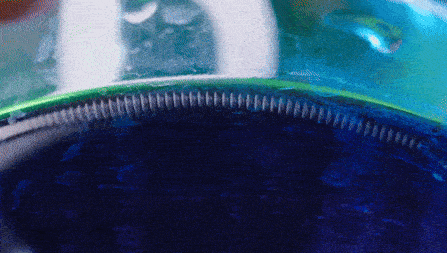Everything around us is made up of tiny building blocks called atoms and molecules—tiny, constantly moving particles. When an object vibrates, these bustling particles move back and forth rapidly. Think of a guitar string when it’s plucked—it vibrates, causing the air around it to vibrate, too. This produces sound waves.
In this Oregon Museum of Science and Industry video, OMSI STEM coordinator Shannon Crowner runs her finger along the rim of the glass, causing its particles to vibrate. What kind of sounds will each glass produce? From OMSI:
“The vibrations in the glass are transferred to the air surrounding the glass, creating a sound wave. You can actually see the vibrations of the glass if you look closely at the water in the glass (especially where the water and the glass are in contact).”

“You can change the pitch of the sound produced by the amount of water you put in the glass. When you add more water to the glass, the pitch is low. This is because the high volume of water in the glass makes it more difficult for the glass particles to vibrate, so the vibrations of the glass are slower and they have a lower frequency.”

When you strum a guitar string, tap a drum, or even speak, you’re setting tiny particles in motion, creating waves that travel to our ears. These waves then make tiny hair cells in our ears vibrate, sending signals to our brain, which interprets them as sound.
But here’s the cool part: the pitch, or how high or low a sound is, depends on the frequency of these vibrations. Higher frequencies mean faster vibrations and higher-pitched sounds, like a bird chirping. Lower frequencies mean slower vibrations and lower-pitched sounds, like a bass drum thumping.

Discover more at OMSI and youtube.com/@OMSImuseum.
Then watch these related videos:
• Sound is a vibration, a demonstration
• Slow Motion Orchestra: Instruments filmed in slow-mo
• The Vessel Orchestra and how instruments make sound
• Odyssey of the Ear, an animated tale of sound
• How does sound travel to our brains?
• Why does a frozen lake sound like a Star Wars blaster?
• The Science Behind String Telephones
Curated, kid-friendly, independently-published. Support this mission by becoming a sustaining member today.

